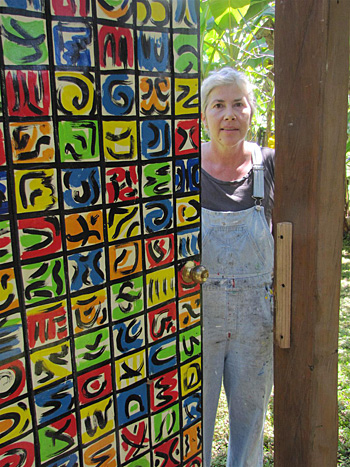As you enter the garden of the Casa de Arte (House of Art) in El Curime of Nicoya, a stone path leads you to a door and a choice. The door, a piece of art in itself, is covered in squares painted with bright colors and designs, and it is symbolic of a choice each of us makes in life.
Artist Helga Denoth explains: "Many people fear in their life; they always go in the road, always they are in the path like the majority and they say yes, that they are happy, but they have dreams and never open the door to see what is behind it, and behind it there is much freedom."
Opening the door and roving about the garden, visitors will find art in the most unexpected forms and surprising places: above a bright colored bench, light fixtures hang from a tree along with star fruit, a painted fan blade turns in the breeze, a fence of old bottles catch the sunlight and twisted bits of metal and sculpted cement hint at faces or figures.
Many of the sculptures are made from recycled items; others are shaped from fiberglass, iron or cement. Inside the Casa de Arte, a 60-year-old house converted into a vibrant gallery of paintings and sculptures, even the floors are a work of art: cement molded and textured using a special technique that Denoth guards secret.
Denoth, originally from Switzerland, has been in Costa Rica since 1994 and moved to El Curime de Nicoya with her family (she is the mother of three) 8 years ago. The moment she saw the old house, she thought "this is it." Though the house was "ugly, ugly, ugly" and the garden was full of trash, Denoth had a vision of the finished product. With an artist's eye, when she looks at a white canvas, she always sees the finished painting. In about a year, Denoth transformed the rundown old house into the House of Art, where almost every morning she can be found working on her latest art project.
At the moment, it is a red concrete sculpture she has named Emma. Not all of her sculptures have names, but they all have souls, she affirms. Within each concrete structure, she hides items to give soul to the sculpture. Within Emma is a bracelet, a bottle and a small ball, denoting play.
While some might look at Emma and just see an oblong red concrete shape, Denoth sees the subtle form of an old woman—her belly, her bust, a shawl around her shoulders, long hair hanging down her back. What each person sees when they look at a work of art is distinct. "It depends on the fantasy of the public," she explains. Many people lack the ability "to see, to see—to open the mind so that the fantasy comes out."
In the middle of the garden, a bird formed of painted driftwood sits perched in a red metal cage. Inspecting closer, you will find that the door to the cage is open. However, the bird doesn't venture out of the cage. "Like many women," Denoth comments.
You might say that Casa de Arte is about this choice: to stay restricted or to open yourself to something new, to a bigger, bolder, fuller, freer world of limitless imagination and art.
To visit Casa de Arte in El Curime, just outside of Nicoya, look for the sign along the main road from Nicoya on the way to Samara. |
|
 |

